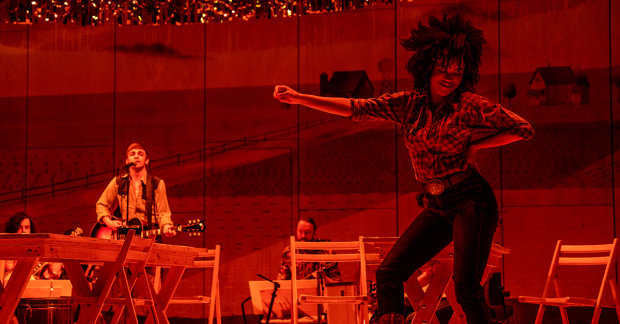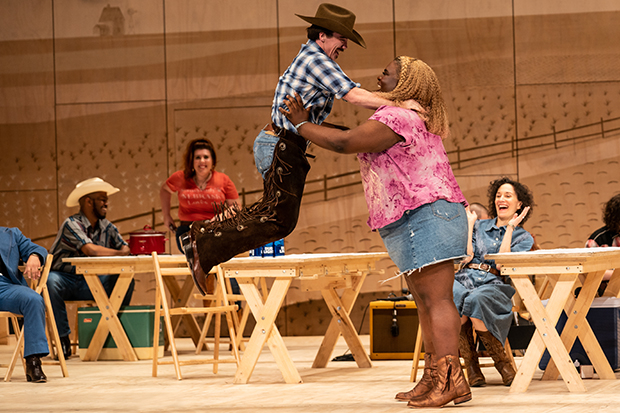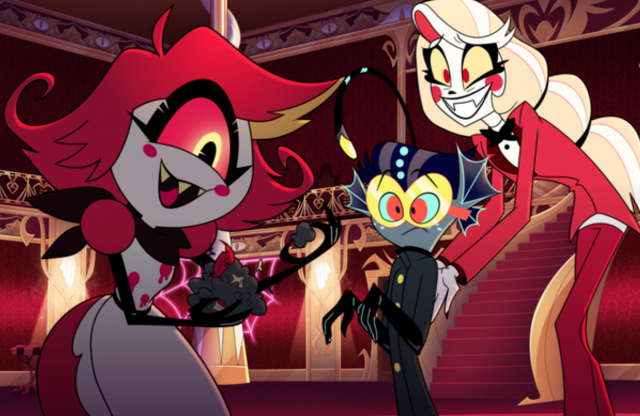Review: Knockout Oklahoma! National Tour Reveals the Classic's Dark Side
Daniel Fish’s Tony-winning production is on tour across the country.

(© MurphyMade)
It wasn't as though I wasn't prepared for a shock. Everybody who cares about musical theater knows that director Daniel Fish has reinvented Rodgers and Hammerstein's beloved 1943 classic Oklahoma! to present a more realistic and therefore diverse America. Without changing a line of the original script, this knockout production, now on tour and currently at the Forrest Theatre in Philadelphia, reveals the show's — and the Heartland's — dark side.
The lighting (by Scott Zelilnski) tells the whole story in its own way: sunny enough in Act One with just a hint of storm clouds, and then deeply dark in Act Two. The set (Laura Jellinek) is a painted backdrop in sepia tones showing immense emptiness punctuated by two tiny houses. On stage there are picnic tables and a tub of corn. The side walls feature many, many gun racks; and hanging from the flies, cheesy brightly colored foil festoons, as if for a gas station opening. In a moment of intense jealousy, the stage is suddenly and briefly drenched in green.
The plot is sex driven — how did we miss that all this time? — as Curly the cowboy (Sean Grandillo) and hired farm hand Jud Fry (the excellent Christopher Bannow) vie for hot stuff Laurey (the beautiful and subtle Sasha Hutchings). But it's not really her "hand" they want. Sex is all anybody talks about, from the peddler Ali Hakim (Benj Mirman) and his aphrodisiac drugs to Will Parker (Hennessy Winkler), whose weekend in Kansas City was a chance to discover strippers, to the pornographic pictures hung in Jud's "lonely room." All the actors inhabit their parts with great physicality: Ado Annie, the comic role of the girl who can't say no, is played by Sis, a Black trans woman who towers over all her beaux.
The show is punctuated by "wow" moments that reveal character. Laurey is silently enraged most of the time, whether she's shucking corn with such vigor as to alarm the first row of the audience or grimly waiting to be auctioned off at the charity hoedown. The dream ballet, usually a romanticized drag on the show's tempo, is here performed by the riveting Gabrielle Hamilton. John Heginbotham's choreography is now, significantly, a solo piece with terrifying moves as she rides in on an invisible horse. Has she become the cowboy in her secret dream?

(© MurphyMade)
Grandillo's Curly, the purported hero, is here a slick and cruel manipulator. He seems so self-consciously suave as to appear detached from any real passion; now and then, he strolls over to the small inconspicuous upstage band, slings on his guitar and strums to accompany himself. His confidence is in perfect contrast to Bannow's Jud, whose flat affect and physical stillness speak the truth of his character. When Jud sings, it is not a performance.
When Curly sings to Laurey, he is so seductively close as to be singing nearly into her mouth; when he talks to Jud Fry, on a totally blacked-out stage, he convinces him that suicide is his best bet. When Jud does die, it is death-by-cowboy; he brings Curly a gun as a wedding present and Laurey is left standing bewildered as the two men do their inevitable battle. Jud emerges as a major character whose loneliness makes him creepily dangerous, but whose sadness generates a surprising sympathy. This is heightened when, during "Pore Jud is Daid," sung by both Curly and Jud, we see their faces in huge projection as tears trickle down Jud's face.
A stunning and hilarious meta-moment occurs in the second act, when the cast assembles for the square dance dressed in cowboy hats and boots and fluffy skirts, and we realize that they are dressed as though for what we'd expect a traditional production of Oklahoma! to look like. The costumes designed by Terese Wadden are telling: super-skinny jeans for Laurey, leather crotch-focusing chaps for Curly, and a rumpled brown suit for Jud's wedding guest clothes with the bizarre detail of pastel blue loafers.
Traditionally, the show ends with a rousing rendition of the title song. Here, the bride and groom are all in white but covered with blood, and when the whole cast sings "Oklahoma!" it is now with a ferocity born not of pride and joy, but of desperation and despair. It gives the production a finale that perfectly suits this radical replay.








